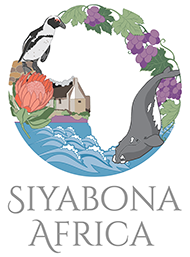Words by Fiona McIntosh
Photographs by Shaen Adey

Table Mountain Activities
Authors: Shaen Adey and Fiona McIntosh.
Copyright © 2004 Struik Publishers Cape Town.
Bird-watching
Although the Cape Peninsula is not endowed with the great variety of birds found in other parts of South Africa, it does support around 155 regularly breeding bird species. Unfortunately, as the Peninsula has become increasingly urbanised, the variety of birdlife has gradually decreased. However, a great place to observe the area's avian population is at the World of Birds in Hout Bay.
This sanctuary is home to many rehabilitated birds, roughly half of which are endemic, housed in large walk-through aviaries. The World of Birds is also home to numerous monkeys and smaller mammals, such as porcupines and mongoose, and a snake enclosure will be a future attraction.
Summit plateau and mountain slopes
If you look skywards, particularly during the autumn breeding season, you may catch sight of a pair of majestic Black Eagles (now renamed Verreaux's Eagles) soaring above the cliffs. In 2003 there were half a dozen breeding pairs on the Peninsula, nesting high on the cliffs and swooping down to catch their favourite food - the dassie, or rock hyrax.The Steppe Buzzard, a summer visitor originating in Europe, Siberia and China, is welcomed with open arms by the Cape's vintners. The medium-sized brown, mottled raptor feeds largely on the rodents and small birds that love to feast on the young grapes. Other commonly sighted predators include the small chestnut Rock Kestrel and the common, but not often sighted, African Goshawk distinguished by its white underparts, which are covered with dark bars. Rock Pigeon, Redwinged Starling, Rock Martins and Alpine and Black Swifts also nest in the upper cliffs.The Bokmakierie, a large shrike with an olive green back and sulphur yellow underparts, is distinguished by its black throat and distinctive call. It is found throughout the hillsides of the Peninsula. The Southern Boubou, a black and white shrike with buff coloured underparts (not dissimilar to the fiscal shrike, but with a shorter tail) is most often seen in the forests on the mountain's eastern flanks. Other species commonly seen and heard on rocky outcrops are the small brown Familiar Chat, the Cape Rock Thrush and the Ground Woodpecker.Fynbos inhabitants
The Cape Floral Kingdom is home to several endemic species, which have evolved to live exclusively on the flowering fynbos. The beautiful, brightly coloured sunbirds flit between flowering ericas and Lion's Paw, gathering nectar with their long, curved beaks, so are particularly easy to observe in spring. Males are much more striking than the females, their colouring being almost metallic. The male Orange-breasted Sunbird, with its bright orange underbelly and metallic green upper parts, is stunning.Also commonly spotted is the smaller, Lesser Double-collared Sunbird (almost endemic - it does occur in the extreme southern part of Namibia), which is predominantly green but with a scarlet bar on its chest. The Malachite Sunbird is less common but breeding males are a striking emerald green. Cape Sugarbirds can usually be seen feeding on nectar from protea bushes and are distinguished by their long tails. Both sexes are brown and long-beaked but the male has a longer tail.
The Cape Bulbul with its distinctive white eyes and yellow undercarriage, is another fynbos inhabitant and you may also catch sight of the Cape Francolin, a dark brown, large game bird, particularly in the Kirstenbosch National Botanical Garden.
Forest dwellers
The orange tail and throat identify the Cape Robin, found largely in the outskirts of the area's forests. It is also easily recognised by the white stripes above its eyes. Other forest inhabitants include the Olive Thrush - an olive-brown thrush distinguished by its orange legs and bill - and the Dusky and Paradise Flycatchers.
The male Paradise Flycatcher sports a magnificent long tail. You are more likely to hear the loud and beautiful song of the rare Common Chaffinch than you are to see it. But keep your eyes peeled for this little beauty should you be wandering around Rhodes Memorial, Newlands Forest or the forests of Tokai and Constantia.
Contact details
The World of Birds Wildlife Sanctuary and Monkey Park
Address: Valley Road, Hout Bay
Tel: 021-790-2730
Fax: 021-790-4839
www.worldofbirds.org.za
Further Reading
Wildlife of the Cape Peninsula, Duncan Butchart, Struik.See p160 for details.
Sasol Birds of Southern Africa, third edition, Norman Arlott, Peter Hayman, Phil Hockey, Ian Sinclair and Warwick Tarboton, Struik

